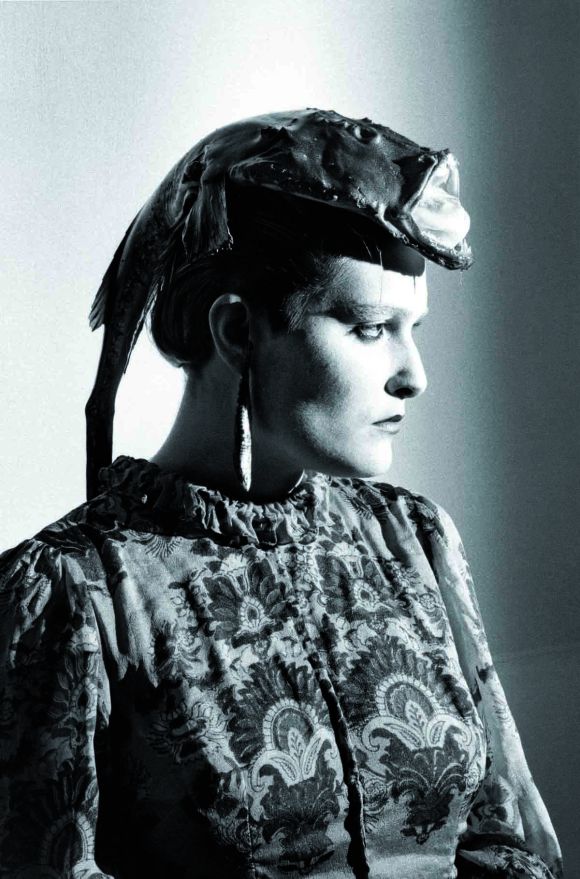 The first time I came face to face with Ouka Levee’s work was this enigmatic lemon-headed woman that was part of the VU’ agency anniversary project called 80+80 which I curated in Pingyao in 2007. I could not explain the work especially when it is catalogued as “photography” because I somehow felt that it looked more like a painting to me, or even like a parody of advertising. The name of the author reminded me of the Hawaiian 4-stringed instrument called Ukulele but did not tell me whether the author was a HE or a SHE. The second time I saw another Ouka Leele work was at a lecture given by Christian Caujolle who recounted the anecdote of how he – at the time photo editor of the Daily Liberation – found a funny picture to illustrate a reporting about a book festival. The picture was of a bearded man with an open book sitting on his head. Again the coloring struck me as unreal. When Caujolle dialed this photographer in Spain he was surprised to find out that was actually a SHE and that she spoke a little French. She told him she first took a photograph in B&W then she enhanced the image using water color. In a way, Ouka Leele defined her art as putting a partition between the photographic paper and the reality and this layer, this partition is painting.
The first time I came face to face with Ouka Levee’s work was this enigmatic lemon-headed woman that was part of the VU’ agency anniversary project called 80+80 which I curated in Pingyao in 2007. I could not explain the work especially when it is catalogued as “photography” because I somehow felt that it looked more like a painting to me, or even like a parody of advertising. The name of the author reminded me of the Hawaiian 4-stringed instrument called Ukulele but did not tell me whether the author was a HE or a SHE. The second time I saw another Ouka Leele work was at a lecture given by Christian Caujolle who recounted the anecdote of how he – at the time photo editor of the Daily Liberation – found a funny picture to illustrate a reporting about a book festival. The picture was of a bearded man with an open book sitting on his head. Again the coloring struck me as unreal. When Caujolle dialed this photographer in Spain he was surprised to find out that was actually a SHE and that she spoke a little French. She told him she first took a photograph in B&W then she enhanced the image using water color. In a way, Ouka Leele defined her art as putting a partition between the photographic paper and the reality and this layer, this partition is painting.
I became curious about the creativity of this Spanish artist who began her career in the late 1970’s after the death of Franco. And I realized she was a key member of the Movida, a cultural and artistic revival of a post-Franco era.
Historically speaking, Spanish dictator General Franco died in Madrid in November 1975, ending 36 years of repression and censorship. King Juan Carlos I facilitated the democratic transition by appointing a new government. By 1977 Spain held the first democratic election in 40 years and a new constitution was signed. Enrique Galvan became the mayor of Madrid: he was the key promoter of the Movida Madrilène. By 1982 for the first time a socialist party came to power and Felipe Gonzalez became prime minister. People in Madrid were excited by the new freedom and turned everything into exuberant celebration and happy revolution. Everyone was free to express whatever he wanted, to have fun, to dress up, to move, to create, that became the “Movement” or “Movida”. It was post-dictatorship, post-censorship, new democracy, new freedom; liberation in all fields including political and sexual, leading to unbridled creativity in art, design, comic strips (Ceesepe), music (Alsaka, Mecano) and cinema (Pedro Almodovar).
Born in 1957, Barbara Allende Ouka Leele described herself this way: “I was born into a family where it was natural to have paint brush, photo camera and cinema camera around. My parents pushed me into this early on. I knew what I wanted to do when I grew up: to paint, and I dreamed of inventing colors. But I didn’t know that I would end up painting photographs. I became hooked by photography the day I saw the magic revelation of an image on a piece of paper. Then I started playing with inventing images, and capturing them with a camera became my language. I was speaking about my own reality through colors and paint brushes. The rest is a boring résumé of love stories, of learning from masters, from dreams and miraculous experiences such as waking up every morning and opening my eye on a new world.”
In that context Ouka Leele’s first work was an homage to the Surrealists who in 1938 have organized the International Exhibition of Surrealism, where 15 artists such as Salvador Dali, Marcel Duchamp, Joan Miro, Max Ernst, etc were given each a dressmaker’s mannequin which they could transform in any way they desired, with Man Ray as the photographer of the end result. One picture by Man Ray at that time also showed Andre Breton as “God” with a crown of thorns on his head. Following that lineage Ouka Leele’s series “Peluquerías” announced clearly the revolutionary nature of a new photographic portraiture: an impressive production of provocative portraits she made of her friends: singers, artists, designers, actors etc, hairdressing them with all sorts of odd and absurd things on their head. These photos shot in B&W were then water-colored into saturated high-contrasted tone to create a distorted representation. The daily home objects, Coca Cola bottles and irons and toasters might constitute a reference to American pop art, but the fish the turtle, and the octopus would relate to Christian symbolism and mythology. More deeply they are exploring one of the most basic instincts of human being: that of transformation through disguise, transvestite, masquerade (see today’s Cosplay). Playing with hair, the emanation of sexuality that we wear openly on our head, this distinctive and remarkable series of portraits proclaims the power of imagination, now totally free of censorship or of any taboo. In her first home movie shot in silent 8mm black & white film in the 1970’s we can see the making of “lemon”: she (Ouka Leele) was laid down on the floor and placed herself the lemons around her head to compose the picture. Her friends wearing an iron or a fish on their head went parading in the street or driving in the tunnels of Madrid. One guy was wearing a huge octopus on his head, he picked up a pair of scisors and cut off its tentacles which dropped to the floor like in a hair salon. A newlywed couple went up a high rise tower with the bride wearing an ensemble of cola bottles and the groom wearing a set of electric shavers….There was such an air of absolute freedom and creativity that we could imagine the fun the Dada and the surrealists were having when they created their art works in the 1920’s, and 1930’s.
In the 1980’s Ouka Leele moved more assertively into traditional painting, especially pictorial classicism, her “tableau-photography” acquiring abundant draperies and more baroque elements, with a stronger flavor of Spanish surrealism (Bunuel, Dali) and a more dramatic stage setting.
The work called “Innocence and Youth” (1984) clearly refers to Goya’s Maja, one of the greatest works of Goya’s made in 1800, a nude is lying on a red velvet couch with a red cushion in the most classic pose. It could perhaps also be a reference to Manet’s Olympia, the black telephone symbolizing the black servant or the black cat in Manet’s painting. The plastic wrap in lieu of draperies could suggest the semi transparent dress for the clothed Maja. It is her way to show the convergence of tradition and modernity.
A more complex staging is the apparently enigmatic “Peor Impossible” (1985) showing a group of people posing on the beach. This painted photography with yellow as the dominant color was originally created as a cover for a Rock band’s album, the name of the band was Peor Impossible, meaning “impossible to be worse than that”, in terms of posing, Ouka Leele may be laughing at her own staging of all these artificial and exaggerated poses. Actually this photo pays homage to the greatest classic painting of all times, Las Meninas (1656) by Velasquez, about the teenage princess with her courtesans, as we know Picasso alone has painted 58 reproductions of Las Meninas. Here the naked man on the foreground plays the role of the dog in the painting. Ouka Leele’s modernity lies in the fact that this is “Cosplay” before the concept even exists. This parody of Velasquez would allow for multiple analyses (why the princess is here offered a green crocodile in lieu of the cup of clay to stop her precocious menstruation as in the original painting?). Velasquez’s remarkable treatment of interior space is here replaced by an open space on the beach. Photography becomes a demonstration by Ouka Leele of an artificial reality even less natural than painting.
To understand the major master piece of Ouka Leele: “Remember, Barbara” this monumental photograph of 150x120cm, three key factors come into consideration. The first is the reference to mythology and in particular to Metamorphosis of the Roman poet Ovid (43-17 BC) – a classic legend about the princess Atalanta who was raised by a bear and who agreed to marry the first man to beat her in a foot race. Eventually, Venus helped out a young man named Hippomenes. She gave him three golden apples to drop during the race and delay her. So he won the race and Atalanta as a wife. But he forgot to thank Aphrodite, who made them consummate their marriage in the sacred temple of the goddess Cybele, who punished them by turning them into lions. This story was made into a classic painting by Guido Reni (born 1575) whose focus was on the two characters Atalanta and Hippomenes forming with their semi naked bodies a striking dissymmetric ballet with the boy sustained in his run towards the right side and the girl stooping to pick up the apple towards the left side. In 1987 Ouka Leele proposed to the mayor of Madrid to hold a sort of “art performance” in the biggest square of the capital, right at the fountain of Cybele with the two stone-lions, by stopping all traffic she created the most dramatic stage set with sixteen models and a whole team to reconstitute the story of Atalanta. And here is the second consideration, this photo painted in pink and orange is actually a declaration of love by Ouka Leele to the city of Madrid. Cybele being the goddess of earth, the artist wanted to affirm her attachment to the city where she was born, to her own roots. She was so intimately connected to the Movida that this picture reflects all that moves and agitation and the contemporary ambiance of the city within the esthetics of classic painting. The last point refers to the title “Remember Barbara” which addresses her real name, Barbara Allende, but which comes from a poem of the French poet Jacques Prevert “Rappelle-toi Barbara” (1946). The artist explains that the title is to remind her never to forget the Cybele inside of herself. In 2005 that is nearly 20 years later, Ouka Leele organized another performance at the same place, this time for an artistic intervention in denouncing violence and abuse, and to help set up a shelter for battered women and children. 300 people had joined her to recreate her picture of 1987, which was filmed by four cameras placed in different places of the Square. Three colors loaded with symbolism, the black of death, the red of life and the white of purity, were used in the costumes for men, women and children who formed a circle around Cybele, goddess of the earth and fertility.
From the 1990’s onwards Ouka Leele’s photographic creation became more intimate, although still elaborate in the staging, especially with nudes. And she seemed to have given up coloring her pictures, and elected to use even digital photography. This nude with mirror is again a typical example of her classicism and her modernism.
Jean Loh
Photo Curator
Shanghai May 2010
Tags: Barbara Allende, Jean Loh, La Movida, Ouka Leele, Peluqueria, Surrealism, Velasquez
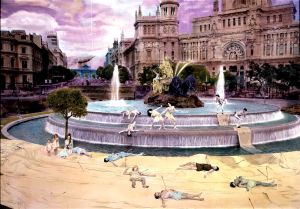
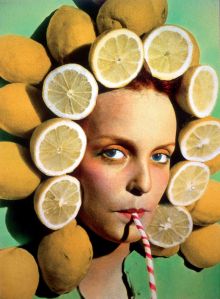
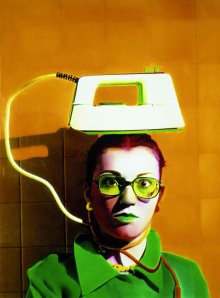
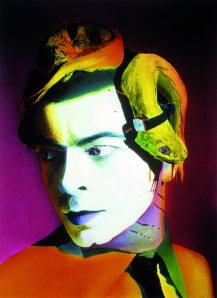
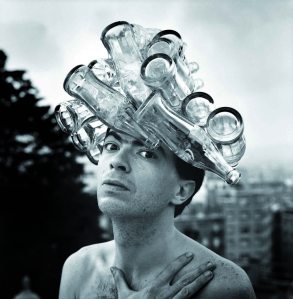
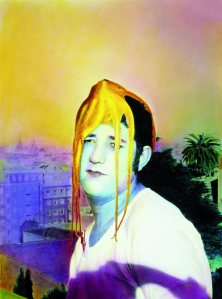
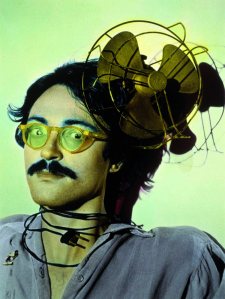
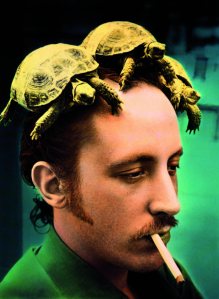
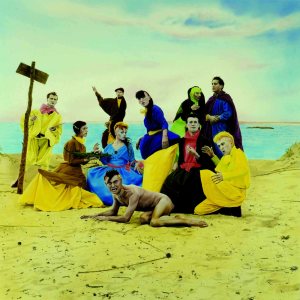
Leave a comment